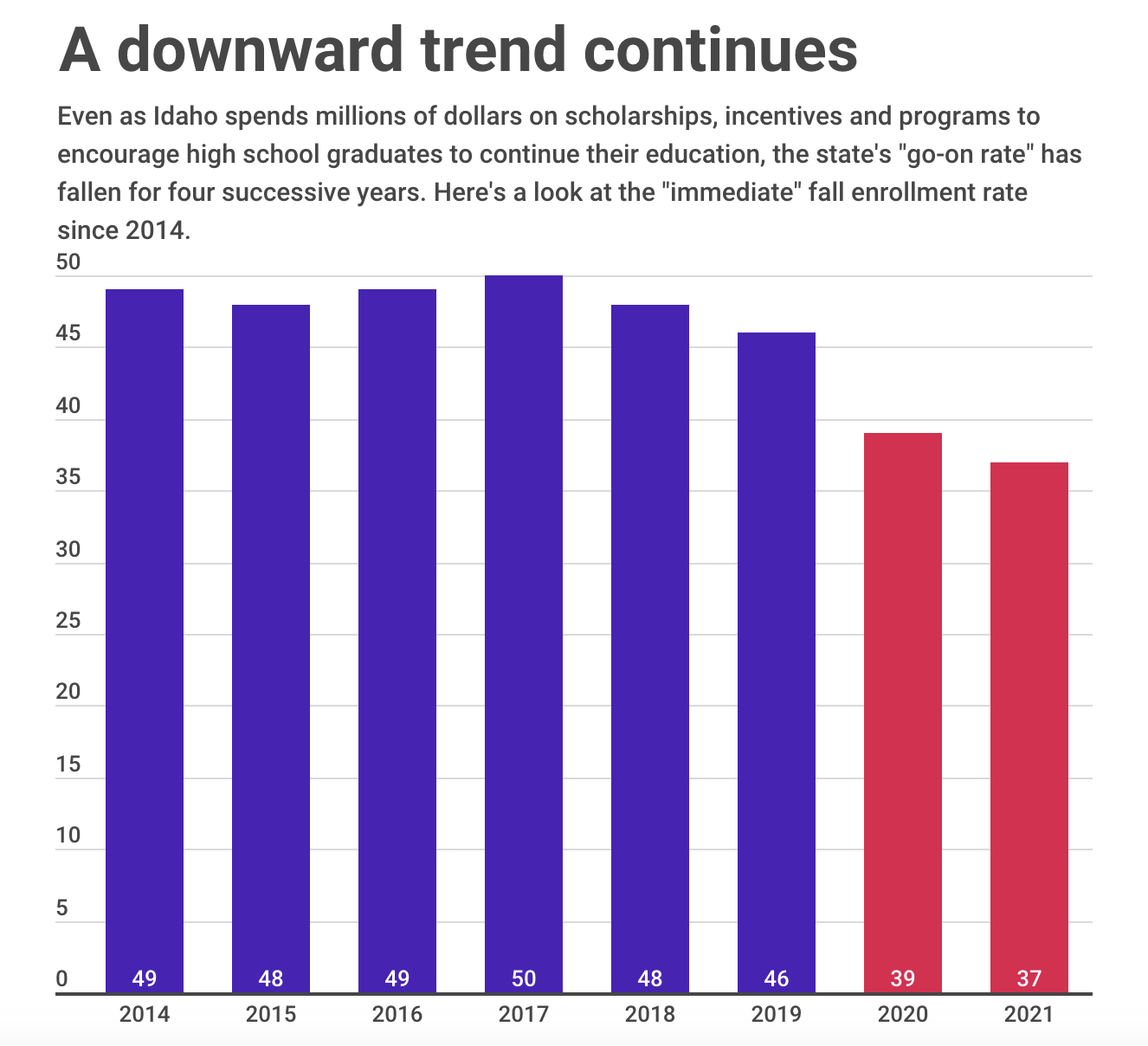 Idaho’s college “go-on rate” continues its pandemic plunge.
Idaho’s college “go-on rate” continues its pandemic plunge.
In 2021, only 37% of the state’s high school graduates went straight to college, down another 2 percentage points from the previous year.
In 2019, before the coronavirus pandemic, the go-on rate stood at 46%.
This year’s go-on rate is the lowest since at least 2014, according to State Board of Education data.
The go-on rate has become one of the state’s most high-profile education metrics — as Idaho wrestles with chronically low college enrollment and graduation rates.
The rate has been dropping for the past four years, and it fell most precipitously in 2020, at the outset of the pandemic. State Board of Education officials aren’t exactly sure what happened this fall.
“We have not done any in-depth analysis on the cause of the decrease,” State Board Chief Research Officer Cathleen McHugh said Tuesday.
The State Board hopes to have an analysis of the numbers later this week, spokesman Mike Keckler said Tuesday afternoon.
This year’s dropoff could be the result of a superheated labor market, with high school graduates choosing a job over college. Or it could reflect lingering pandemic issues — with prospective students sitting out because of health concerns, or because they’re worried that their college could close its campus or shift to online instruction.
Or the causes could be more complex.
McHugh pointed to State Board research from 2020. Economically disadvantaged students did opt out of college; their go-on rate fell by 4 percentage points. But for students who were not economically disadvantaged, the dropoff was 10 percentage points — suggesting these students took a gap year because they could afford to do so.
Regardless of the cause, the 2021 dropoff isn’t a surprise.
Idaho college enrollment increased last fall, nearing pre-pandemic levels. But this rebound generally came from a robust, outsized increase in out-of-state enrollment — and not because of a spike in in-state enrollment.
The fall go-on rate is a snapshot, and an incomplete picture. It measures only the number of students who head straight to college after high school — and doesn’t account for students who serve a church mission, enter the military or take a job to earn money for college.
For the high school class of 2018, the three-year go-on rate came in at 60%.
But that represents a dropoff as well. For the four preceding years, this rate had hovered between 63% and 64%.
The declining numbers represent another setback in Idaho’s long go-on battle.
For years, business, education and political leaders have looked for ways to encourage high school graduates to continue their education.
The Legislature has responded by pouring tens of millions of dollars into a menu of taxpayer-funded programs designed to encourage young adults to stay in school: merit- and need-based college scholarships; college-level dual-credit courses for high school students; college and career counselors; and free “SAT Day” in Idaho high schools.
The 2022 Legislature will consider putting about $20 million into the college Opportunity Scholarship, and $33 million for the advanced opportunities program that covers high school students’ dual-credit courses.
Political reactions
In a statement Tuesday, state superintendent Sherri Ybarra pinned the decrease to the pandemic — and the strong job market.
“This trend is not surprising given the significant disruptions to education over the past three academic years,” she said. “Historically, there is often a high correlation between low unemployment and low postsecondary enrollment, with more young people opting to join the workforce and delay college.”
Republican state superintendent’s candidate Debbie Critchfield touted the importance of community colleges and career-technical education.
“I think what we’re seeing play out in the decline of the go-on rate is a disconnect between what students are looking for and what’s been prioritized in high school,” she said. “With nearly 80% of high school students taking some form of dual credit, but less than 40% college enrollment rate, clearly students are looking for a way to get a jumpstart on skills that prepare them for work and life.”
Republican state superintendent’s candidate Branden Durst did not respond to a request for comment Tuesday.
In a statement, spokeswoman Marissa Morrison Hyer touted Gov. Brad Little’s 2023 education budget requests for K-12, career-technical education and two- and four-year postsecondary schools.
“Gov. Little recognizes the pandemic has had many impacts, and that is why he is committed to investing in education and workforce training,” Hyer said.
Republican gubernatorial candidate Ed Humphreys took a different view. “We have a labor shortage and a housing shortage,” he said Tuesday. “I think it’s great to see young people opting to develop skills in the workforce. They’re creating value for themselves and our communities.”
Democratic gubernatorial candidate Shelby Rognstad placed the blame with Little and the GOP-dominated Legislature. “This is yet another disturbing statistic that confirms what parents and teachers already know. Idaho state government is failing our students. The governor and Legislature have chosen to spend our tax dollars on rebates for the wealthy, rather than on students and schools. Quality education is the best path to lasting prosperity for Idaho families. “
Idaho Education News requested comment from Republican Lt. Gov. Janice McGeachin and GOP gubernatorial candidate Ammon Bundy; check back for any updates.
